The ophthalmic stereoscopic 3D display market enters a decade of measured expansion that will transform surgical visualization and diagnostic capabilities across eye care facilities, surgical centers, and ophthalmic treatment applications. The market's progression from USD 47.4 million in 2025 to USD 75.8 million by 2035 represents controlled growth, reflecting the accelerated adoption of advanced visualization technology and 3D surgical systems across ophthalmic procedures, diagnostic applications, and specialized eye care operations worldwide.
The first half of the decade (2025-2030) will witness the market climbing from USD 47.4 million to approximately USD 59.9 million, adding USD 12.5 million in value, which constitutes 44% of the total forecast growth period. This phase will be characterized by the continued adoption of heads-up surgical systems and microscope-integrated solutions, driven by increasing surgical precision demands and the growing need for enhanced visualization capabilities in cataract surgery, retinal procedures, and diagnostic applications globally. Enhanced display technology and automated imaging systems will become standard expectations rather than premium options.
The latter half (2030-2035) will witness continued growth from USD 59.9 million to USD 75.8 million, representing an addition of USD 15.8 million or 56% of the decade's expansion. This period will be defined by mass market penetration of AR-assisted 3D systems, integration with comprehensive surgical platforms, and seamless compatibility with existing ophthalmic equipment infrastructure. The market trajectory signals fundamental shifts in how ophthalmic surgeons approach visualization technology and surgical operations, with participants positioned to benefit from growing demand across multiple application segments and display technology channels.
Ophthalmic stereoscopic 3D display systems encompass sophisticated visualization management platforms coordinating heads-up surgical displays, microscope-integrated cameras, and diagnostic viewers across diverse surgical and clinical applications. Heads-up surgical visualization systems provide enhanced depth perception through real-time stereoscopic imaging displayed on external monitors, eliminating the need for traditional microscope eyepieces while maintaining surgical precision. Working magnifications typically range from 4x to 40x with image resolution capabilities supporting ultra-high definition display standards for detailed tissue visualization and surgical guidance.
Vitreoretinal surgery applications drive primary market demand through requirements for precise membrane peeling, retinal repair procedures, and complex posterior segment interventions requiring enhanced depth perception and visual clarity. Cataract surgery operations utilize 3D visualization systems for improved lens fragmentation visualization, capsular bag management, and intraocular lens positioning during phacoemulsification procedures. Corneal and anterior segment applications encompass keratoplasty procedures, glaucoma surgery, and refractive operations requiring detailed anterior chamber visualization and surgical precision.
LCD display technology maintains market leadership through proven performance characteristics, cost-effectiveness, and integration capabilities with existing surgical microscope platforms. OLED systems provide enhanced contrast ratios and color accuracy for demanding surgical applications requiring superior image quality and real-time tissue differentiation capabilities.
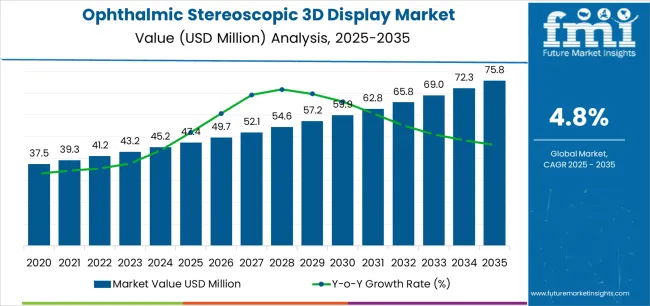
| Period | Primary Revenue Buckets | Share | Notes |
|---|---|---|---|
| Today | Heads-up 3D Surgical Visualization Systems | 53.7% | Volume-driven, surgical focus |
| Microscope-add-on 3D camera systems | 28.1% | Integration and retrofit applications | |
| 3D clinical/diagnostic viewers | 18.2% | Diagnostic and screening | |
| Glasses-based technology | 83.8% | Primary viewing method | |
| LCD display type | 63.7% | Standard display technology | |
| Future (3-5 yrs) | Enhanced surgical visualization systems | 56.1% | Technology advancement, precision gains |
| Expanded microscope solutions | 29.4% | Integration improvement, system expansion | |
| Advanced diagnostic platforms | 14.5% | Technology consolidation, efficiency gains | |
| Optimized glasses-based systems | 81.9% | Performance enhancement, user experience | |
| Enhanced LCD platforms | 65.2% | Display improvement, quality advancement | |
| Digital integration platforms | 5-8% | IoT connectivity, data optimization |
| Metric | Value |
|---|---|
| Market Value (2025) | USD 47.4 million |
| Market Forecast (2035) | USD 75.7 million |
| Growth Rate | 4.8% CAGR |
| Leading Type | Heads-up 3D Surgical Visualization Systems |
| Primary Application | Vitreoretinal Surgery |
The market demonstrates strong fundamentals with heads-up surgical visualization systems capturing a dominant share through advanced surgical capabilities and visualization optimization. Vitreoretinal applications drive primary demand, supported by increasing surgical requirements and operational precision development. Geographic expansion remains concentrated in developed markets with established ophthalmic infrastructure, while emerging economies show accelerating adoption rates driven by healthcare modernization initiatives and rising surgical accessibility standards.
Design for surgical versatility, not just display quality
Technology readiness for Surgery 4.0
Precision-by-design approach
Value-based surgical models
Primary Classification: The market segments by type into heads-up 3D surgical visualization systems (53.7%), microscope-add-on 3D camera systems (28.1%), and 3D clinical/diagnostic viewers (18.2%), representing the evolution from basic imaging methods to specialized visualization platforms for comprehensive surgical and diagnostic optimization.
Secondary Classification: Technology segmentation divides the market into glasses-based (83.8%), glasses-free (5.0%), and head-mounted/AR-assisted 3D (11.2%) systems, reflecting distinct requirements for user experience, surgical workflow, and operating room infrastructure standards.
Tertiary Classification: Display type segmentation covers LCD (63.7%), OLED (28.0%), and Micro-OLED (8.3%) systems, demonstrating varied display requirements and performance efficiency standards.
Quaternary Classification: Application segmentation encompasses vitreoretinal surgery (43.2%), cataract & IOL (20.0%), cornea & anterior (12.0%), glaucoma (8.0%), and diagnostics (16.8%) applications, demonstrating varied surgical requirements and procedure efficiency standards.
Quinary Classification: End user segmentation covers eye hospitals (48.4%), ophthalmic clinics (25.8%), general hospitals (13.9%), and academic & research institutes (11.9%), demonstrating varied facility requirements and operational distribution standards.
The segmentation structure reveals technology progression from standard visualization methods toward specialized 3D display applications with enhanced surgical consistency and precision capabilities, while application diversity spans from complex retinal surgery to routine cataract procedures requiring precise visualization solutions.
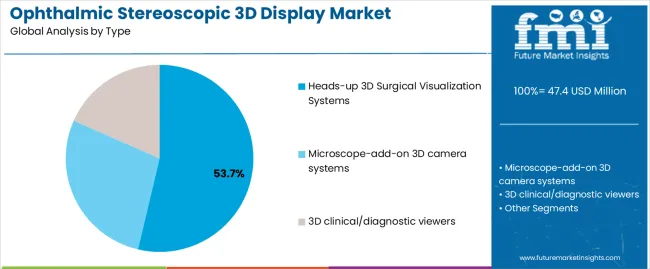
Market Position: Heads-up 3D surgical visualization systems command the leading position in the ophthalmic stereoscopic 3D display market with 53.7% market share through advanced surgical features, including superior ergonomic benefits, operational efficiency, and visualization optimization that enable surgeons to achieve optimal precision across diverse ophthalmic procedures and surgical applications.
Value Drivers: The segment benefits from surgeon preference for ergonomic surgical systems that provide consistent visualization performance, reduced neck strain, and operational efficiency optimization without requiring significant microscope modifications. Advanced display features enable automated image enhancement, recording capabilities, and integration with existing surgical equipment, where surgical performance and visualization quality represent critical operative requirements.
Competitive Advantages: Heads-up surgical visualization systems differentiate through proven surgical reliability, consistent image characteristics, and integration with automated surgical management systems that enhance procedural effectiveness while maintaining optimal precision standards for diverse ophthalmic and surgical applications.
Key market characteristics:
Microscope-add-on 3D Camera Systems Show Integration Market Growth
Microscope-add-on 3D camera systems maintain a 28.1% market position in the ophthalmic stereoscopic 3D display market due to their enhanced retrofit properties and existing microscope integration characteristics. These systems appeal to facilities requiring specialized performance with premium positioning for microscope upgrade and integration applications. Market growth is driven by surgical facility segment expansion, emphasizing versatile visualization solutions and operational efficiency through optimized camera designs.
3D Clinical/Diagnostic Viewers Applications Show Specialized Growth
3D clinical/diagnostic viewers capture 18.2% market share through specialized visualization requirements in diagnostic procedures, screening operations, and clinical applications. These operations demand certified diagnostic systems capable of operating with clinical workflow while providing effective visualization management and diagnostic performance capabilities.
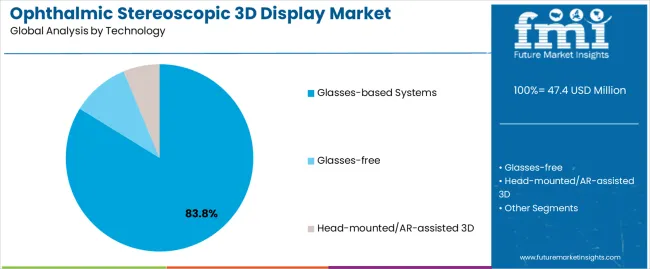
Market Context: Glasses-based technology demonstrates market leadership in the ophthalmic stereoscopic 3D display market with 83.8% share due to widespread adoption of proven visualization systems and increasing focus on user comfort, surgical workflow efficiency, and display applications that maximize depth perception while maintaining operational standards.
Appeal Factors: Surgical professionals prioritize visualization reliability, operational comfort, and integration with existing surgical infrastructure that enables coordinated procedural operations across multiple surgical applications. The segment benefits from substantial technology investment and development programs that emphasize the acquisition of glasses-based systems for surgical optimization and visualization efficiency applications.
Growth Drivers: Surgical facility expansion programs incorporate glasses-based technology as standard visualization for surgical operations, while procedural growth increases demand for consistent visualization capabilities that comply with surgical standards and minimize operational complexity.
Glasses-free Technology Maintains Emerging Applications
Glasses-free technology captures 5.0% market share through comprehensive visualization requirements in specialized procedures, advanced surgical operations, and next-generation applications requiring hands-free visualization systems capable of operating within surgical environments while providing effective display management and operational performance capabilities.
Head-mounted/AR-assisted 3D Systems Show Advanced Growth
Head-mounted/AR-assisted 3D systems account for 11.2% market share, including specialized surgical applications, advanced visualization requirements, and next-generation procedural applications requiring immersive display solutions for surgical optimization and visualization accessibility.
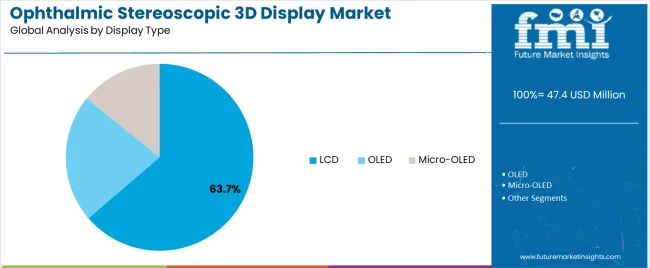
Market Context: LCD display technology demonstrates market leadership in the ophthalmic stereoscopic 3D display market with 63.7% share due to widespread adoption of established display systems and increasing focus on cost efficiency, display reliability, and visualization applications that maximize performance while maintaining quality standards.
Appeal Factors: Healthcare providers prioritize display consistency, operational efficiency, and integration with existing surgical infrastructure that enables coordinated visualization operations across multiple surgical applications. The segment benefits from substantial display investment and modernization programs that emphasize the acquisition of LCD-based systems for surgical optimization and display efficiency applications.
Growth Drivers: Surgical facility expansion programs incorporate LCD technology as standard display for visualization operations, while surgical growth increases demand for consistent display capabilities that comply with quality standards and minimize operational complexity.
OLED Display Systems Maintain Premium Applications
OLED display technology captures 28.0% market share through comprehensive visualization requirements in premium surgical procedures, advanced operations, and high-end applications requiring superior display systems capable of handling demanding surgical environments while providing effective color management and display performance capabilities.
Micro-OLED Systems Show Specialized Growth
Micro-OLED systems account for 8.3% market share, including compact applications, portable systems, and specialized visualization requirements for surgical optimization and display accessibility.
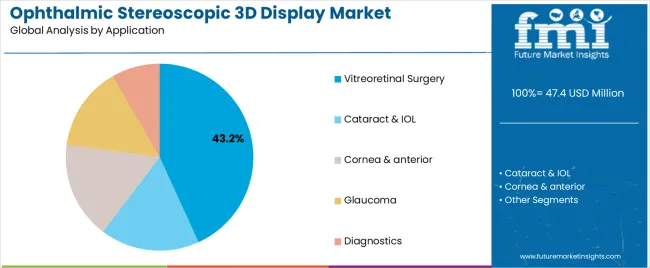
Market Context: Vitreoretinal surgery applications demonstrate market leadership in the ophthalmic stereoscopic 3D display market with 43.2% share due to widespread adoption of complex surgical systems and increasing focus on surgical precision, procedural complexity, and visualization applications that maximize surgical outcomes while maintaining safety standards.
Appeal Factors: Retinal surgeons prioritize visualization precision, surgical accuracy, and integration with existing surgical infrastructure that enables coordinated procedural operations across multiple surgical applications. The segment benefits from substantial surgical investment and technology programs that emphasize the acquisition of advanced visualization systems for surgical optimization and procedural efficiency applications.
Growth Drivers: Retinal surgery expansion programs incorporate 3D visualization as standard equipment for surgical operations, while procedural growth increases demand for consistent visualization capabilities that comply with surgical standards and minimize procedural complexity.
Application dynamics include:
Cataract & IOL Applications Maintain Surgical Demand
Cataract & IOL applications capture 20.0% market share through comprehensive surgical requirements in lens replacement procedures, phacoemulsification operations, and routine surgical applications. These operations demand reliable visualization systems capable of handling high-volume surgical environments while providing effective procedural management and surgical performance capabilities.
Cornea & Anterior Applications Show Specialized Growth
Cornea & anterior segment applications account for 12.0% market share, including corneal transplant procedures, anterior chamber surgery, and specialized surgical requirements for procedural optimization and surgical accessibility.
Glaucoma Applications Show Procedure-Specific Growth
Glaucoma applications account for 8.0% market share, including drainage procedures, filtration surgery, and specialized glaucoma surgical requirements for procedural optimization and pressure management.
Diagnostics Applications Show Clinical Growth
Diagnostics applications account for 16.8% market share, including screening procedures, clinical examination, and diagnostic visualization requirements for clinical optimization and patient assessment.
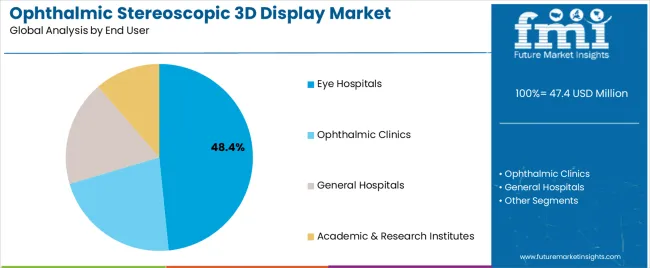
Market Context: Eye hospitals demonstrate market leadership in the ophthalmic stereoscopic 3D display market with 48.4% share due to widespread adoption of specialized surgical systems and increasing focus on surgical volume, procedural efficiency, and visualization applications that maximize patient outcomes while maintaining operational standards.
Appeal Factors: Hospital administrators prioritize surgical efficiency, operational reliability, and integration with existing hospital infrastructure that enables coordinated surgical operations across multiple procedural applications. The segment benefits from substantial hospital investment and modernization programs that emphasize the acquisition of advanced visualization systems for surgical optimization and operational efficiency applications.
Growth Drivers: Eye hospital expansion programs incorporate 3D visualization as standard equipment for surgical operations, while hospital growth increases demand for consistent visualization capabilities that comply with operational standards and minimize surgical complexity.
Application dynamics include:
Ophthalmic Clinics Maintain Specialized Care
Ophthalmic clinics capture 25.8% market share through comprehensive surgical requirements in specialized procedures, ambulatory operations, and clinic-based applications. These operations demand reliable visualization systems capable of handling specialized surgical environments while providing effective procedural management and clinical performance capabilities.
General Hospitals Show Integrated Care
General hospitals account for 13.9% market share, including multi-specialty procedures, integrated surgical services, and hospital-based applications requiring versatile visualization solutions for surgical optimization and patient care.
Academic & Research Institutes Show Educational Growth
Academic & research institutes account for 11.9% market share, including training applications, research procedures, and educational visualization requirements for academic optimization and research advancement.
| Category | Factor | Impact | Why It Matters |
|---|---|---|---|
| Driver | Aging population growth & eye disease prevalence (cataract incidence, retinal disorders) | ★★★★★ | Large-scale aging markets require efficient, reliable surgical solutions with consistent performance and safety compliance across ophthalmic applications. |
| Driver | Surgical precision advancement & visualization technology (3D imaging, depth perception) | ★★★★★ | Drives demand for specialized visualization solutions and high-precision surgical capabilities; providers offering advanced 3D systems gain competitive advantage. |
| Driver | Minimally invasive surgery adoption & ergonomic benefits (heads-up surgery, surgeon comfort) | ★★★★☆ | Surgical markets need ergonomic solutions; demand for comfort-enhancing technology expanding addressable surgeon segments. |
| Restraint | High system costs & capital investment (equipment expense, integration complexity) | ★★★★☆ | Small surgical centers face cost pressure; increases price sensitivity and affects adoption in budget-sensitive markets. |
| Restraint | Traditional microscopy competition & established workflows (conventional visualization, surgeon preference) | ★★★☆☆ | Cost-focused applications face challenges with technology adoption and workflow requirements, limiting adoption in traditional segments. |
| Trend | AR integration advancement & smart surgery (augmented reality, digital enhancement) | ★★★★★ | Growing demand for smart surgical equipment; AR integration becomes core value proposition in advanced surgical segments. |
| Trend | Asian market expansion & regional surgical growth (facility development, procedure volume) | ★★★★☆ | Regional surgical development drives demand for local visualization solutions; regional adoption capabilities drive competition toward localization. |
The ophthalmic stereoscopic 3D display market demonstrates varied regional dynamics with growth leaders including USA (5.4% growth rate) and Germany (5.2% growth rate) driving expansion through advanced surgical initiatives and visualization capacity development. Steady Performers encompass Europe (5.0% growth rate), France (4.4% growth rate), and UK (4.0% growth rate), benefiting from established healthcare industries and advanced surgical adoption. Mature Markets feature China (3.9% growth rate), Brazil (3.7% growth rate), and India (3.4% growth rate), where healthcare technology advancement and surgical standardization requirements support consistent growth patterns.
Regional synthesis reveals North American and European markets leading adoption through surgical expansion and visualization development, while Asian countries maintain steady expansion supported by technology advancement and regulatory standardization requirements. Emerging markets show strong growth driven by surgical applications and facility modernization trends.
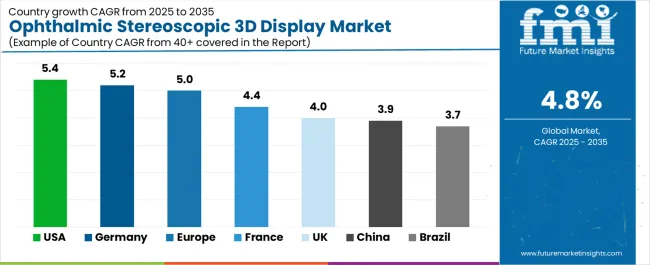
| Region/Country | 2025-2035 Growth | How to win | What to watch out |
|---|---|---|---|
| USA | 5.4% | Focus on advanced surgical integration solutions | FDA regulations; reimbursement complexity |
| Germany | 5.2% | Lead with precision surgical systems | Regulatory compliance; cost controls |
| Europe | 5.0% | Offer comprehensive surgical programs | Market fragmentation; pricing pressure |
| France | 4.4% | Provide integrated visualization solutions | Healthcare budget constraints; adoption barriers |
| UK | 4.0% | Premium surgical positioning | NHS limitations; Brexit impacts |
| China | 3.9% | Push hospital-based integration solutions | Regulatory approval; market access |
| Brazil | 3.7% | Premium surgical positioning | Economic volatility; infrastructure challenges |
| India | 3.4% | Premium healthcare positioning | Infrastructure challenges; cost sensitivity |
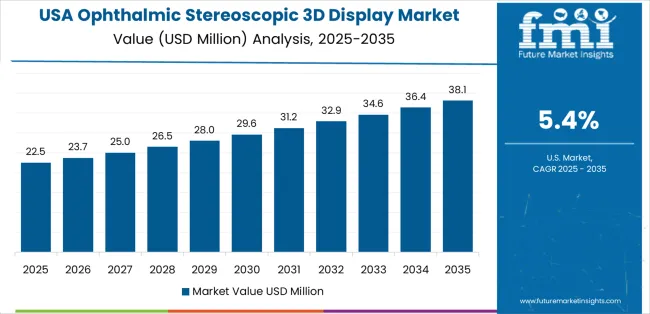
USA establishes fastest market growth through comprehensive surgical programs and advanced visualization capacity development, integrating advanced ophthalmic stereoscopic 3D displays as standard components in eye hospital systems and surgical facility installations. The country's 5.4% growth rate reflects government initiatives promoting healthcare modernization and surgical development capabilities that mandate the use of advanced visualization systems in ophthalmic facilities. Growth concentrates in major surgical centers, including California, Texas, and New York, where surgical technology development showcases integrated 3D systems that appeal to surgeons seeking advanced visualization optimization capabilities and operational surgical applications.
American surgical equipment companies are developing advanced visualization solutions that combine domestic research advantages with proven surgical features, including automated calibration systems and enhanced precision capabilities. Distribution channels through hospital systems and surgical equipment distributors expand market access, while regulatory support for healthcare development supports adoption across diverse surgical segments.
Strategic Market Indicators:
In North Rhine-Westphalia, Bavaria, and Baden-Württemberg regions, surgical facilities and ophthalmic operations are implementing advanced stereoscopic 3D displays as standard equipment for surgical optimization and operational precision enhancement, driven by increasing government healthcare investment and surgical modernization programs that emphasize the importance of precision visualization capabilities. The market holds a 5.2% growth rate, supported by government surgical initiatives and visualization infrastructure development programs that promote advanced display systems for surgical facilities.
German operators are adopting visualization systems that provide consistent surgical performance and regulatory compliance features, particularly appealing in surgical regions where procedural efficiency and precision standards represent critical operational requirements. Market expansion benefits from growing surgical processing capabilities and healthcare integration agreements that enable domestic production of advanced visualization systems for surgical applications.
Europe establishes comprehensive surgical development through established healthcare programs and advanced visualization infrastructure, integrating ophthalmic stereoscopic 3D displays across surgical facilities and clinical applications. The region's 5.0% growth rate reflects mature healthcare industry relationships and established surgical adoption that supports widespread use of visualization systems in ophthalmic facilities and surgically-compliant operations. Growth concentrates in major surgical centers, including Germany, France, and Italy, where surgical technology showcases mature visualization deployment that appeals to surgeons seeking proven precision capabilities and operational efficiency applications.
European surgical equipment companies leverage established distribution networks and comprehensive surgical capabilities, including regulatory programs and technical support that create surgeon relationships and operational advantages. The market benefits from mature surgical standards and regulatory requirements that support visualization system use while supporting technology advancement and operational optimization.
France establishes integrated visualization development through advanced surgical programs and established healthcare infrastructure, integrating ophthalmic stereoscopic 3D systems across surgical facilities and clinical applications. The country's 4.4% growth rate reflects growing healthcare industry relationships and established visualization adoption that supports widespread use of display systems in ophthalmic facilities and care-integrated operations. Growth concentrates in major surgical centers, including Paris, Lyon, and Marseille, where surgical technology showcases mature visualization deployment that appeals to surgeons seeking proven integration capabilities and operational efficiency applications.
French surgical systems leverage established clinical networks and comprehensive support capabilities, including surgical programs and technical support that create surgeon relationships and operational advantages. The market benefits from established surgical standards and clinical requirements that support visualization system use while supporting technology advancement and operational optimization.
UK's advanced surgical technology market demonstrates sophisticated ophthalmic stereoscopic 3D integration with documented surgical effectiveness in premium ophthalmic applications and modern facility installations through integration with existing surgical systems and healthcare infrastructure. The country maintains a 4.0% growth rate, leveraging traditional surgical expertise and precision systems integration in visualization technology. Surgical centers, including London, Manchester, and Birmingham, showcase premium installations where visualization systems integrate with traditional surgical platforms and modern facility management systems to optimize ophthalmic operations and maintain surgical quality profiles.
British surgical providers prioritize visualization precision and surgical consistency in display development, creating demand for premium systems with advanced features, including surgical monitoring and automated visualization systems. The market benefits from established surgical infrastructure and commitment to surgical standards that provide long-term operational benefits and compliance with traditional quality surgical methods.
China establishes hospital-based integration development through comprehensive facility modernization and technology integration, integrating ophthalmic stereoscopic 3D systems across healthcare facilities and specialized surgical applications. The country's 3.9% growth rate reflects growing healthcare investment and increasing adoption of visualization technology that supports expanding use of display systems in Chinese ophthalmic facilities. Growth concentrates in major healthcare areas, including Beijing, Shanghai, and Guangzhou, where surgical technology development showcases integrated visualization systems that appeal to Chinese surgeons seeking advanced hospital solutions with facility efficiency compatibility.
Chinese healthcare systems focus on maintaining quality standards while adopting surgical visualization efficiency, creating demand for systems that balance performance with operational advantages. The market benefits from strong healthcare infrastructure and growing surgical opportunities that support visualization technology adoption while maintaining quality standards important to Chinese surgical applications.
Brazil's advancing surgical technology market demonstrates sophisticated ophthalmic stereoscopic 3D integration with documented surgical effectiveness in premium ophthalmic applications and modern facility installations through integration with existing surgical systems and healthcare infrastructure. The country maintains a 3.7% growth rate, leveraging traditional surgical expertise and precision systems integration in visualization technology. Surgical centers, including São Paulo, Rio de Janeiro, and Brasília, showcase premium installations where visualization systems integrate with traditional surgical platforms and modern facility management systems to optimize ophthalmic operations and maintain surgical quality profiles.
Brazilian surgical providers prioritize visualization precision and surgical consistency in display development, creating demand for premium systems with advanced features, including surgical monitoring and automated visualization systems. The market benefits from established surgical infrastructure and commitment to surgical standards that provide long-term operational benefits and compliance with traditional quality surgical methods.
Advancing healthcare technology market in India demonstrates sophisticated ophthalmic stereoscopic 3D integration with documented surgical effectiveness in premium ophthalmic applications and modern facility installations through integration with existing healthcare systems and surgical infrastructure. The country maintains a 3.4% growth rate, leveraging traditional healthcare expertise and precision systems integration in visualization technology. Healthcare centers, including Delhi, Mumbai, and Bangalore, showcase premium installations where visualization systems integrate with traditional healthcare platforms and modern facility management systems to optimize surgical operations and maintain healthcare quality profiles.
Indian healthcare providers prioritize visualization precision and surgical consistency in display development, creating demand for premium systems with advanced features, including surgical monitoring and automated visualization systems. The market benefits from established healthcare infrastructure and commitment to surgical standards that provide long-term operational benefits and compliance with traditional quality healthcare methods.
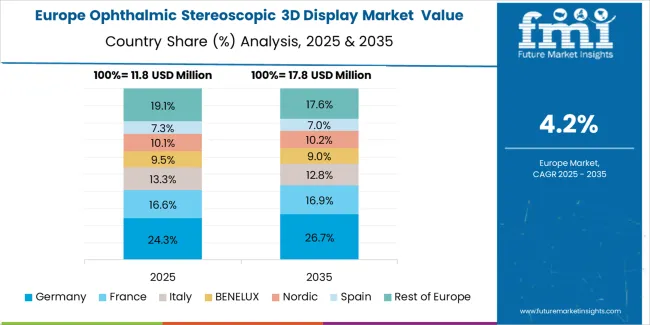
The European ophthalmic stereoscopic 3D display market is projected to represent a significant portion of global consumption, with strong regional distribution across major economies. Germany is expected to maintain its leadership position with USD 3.9 million in 2025, accounting for 27.9% European market share, supported by its advanced surgical infrastructure and major ophthalmic centers.
United Kingdom follows with USD 3.2 million, representing 23.1% European market share in 2025, driven by comprehensive surgical programs and visualization technology development initiatives. France holds USD 2.4 million through specialized surgical applications and visualization compliance requirements. Italy commands USD 1.7 million, while Spain accounts for USD 1.2 million in 2025. BENELUX maintains USD 0.8 million, Nordic Countries hold USD 0.5 million, and the rest of Western Europe region accounts for USD 0.3 million, attributed to increasing visualization system adoption in emerging surgical facilities implementing ophthalmic modernization programs.
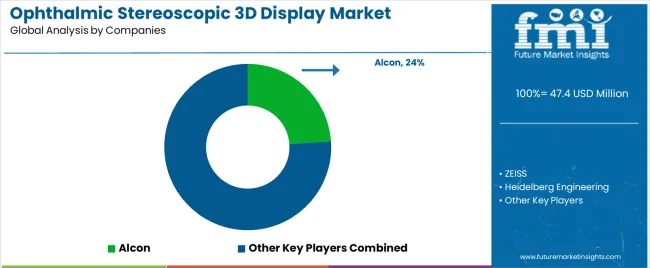
| Stakeholder | What they actually control | Typical strengths | Typical blind spots |
|---|---|---|---|
| Global platforms | Distribution networks, broad surgical portfolios, manufacturing facilities | Proven reliability, multi-region support, comprehensive service | Technology refresh cycles; customer lock-in dependency |
| Technology innovators | R&D capabilities; advanced visualization systems; digital interfaces | Latest technology first; attractive ROI on specialized applications | Service density outside core regions; customization complexity |
| Regional specialists | Local sourcing, fast delivery, nearby technical support | "Close to site" support; pragmatic pricing; local regulations | Technology gaps; talent retention in surgical development |
| Application-focused ecosystems | Surgical expertise, integration support, specialized solutions | Lowest application variation; comprehensive surgical support | Scaling costs if overpromised; technology obsolescence |
| Service specialists | Integration programs, system supply, surgical training | Win service-intensive applications; flexible support | Scalability limitations; narrow market focus |
Key Players in the Ophthalmic Stereoscopic 3D Display Market
| Items | Values |
|---|---|
| Quantitative Units (2025) | USD 47.4 million |
| Type | Heads-up 3D Surgical Visualization Systems, Microscope-add-on 3D camera systems, 3D clinical/diagnostic viewers |
| Technology | Glasses-based, Glasses-free, Head-mounted/AR-assisted 3D |
| Display Type | LCD, OLED, Micro-OLED |
| Application | Vitreoretinal surgery, Cataract & IOL, Cornea & anterior, Glaucoma, Diagnostics |
| End User | Eye Hospitals, Ophthalmic Clinics, General Hospitals, Academic & Research Institutes |
| Regions Covered | East Asia, Western Europe, South Asia Pacific, North America, Latin America, Middle East & Africa |
| Countries Covered | China, Germany, United States, Japan, India, South Korea, Brazil, France, United Kingdom, and 25+ additional countries |
| Key Companies Profiled | Alcon, ZEISS, Heidelberg Engineering, Bausch + Lomb, Leica Microsystems, Ocutrx Technologies, Beyeonics Vision, Haag-Streit, Sony, Munich Surgical Imaging |
| Additional Attributes | Dollar sales by type and technology categories, regional adoption trends across East Asia, Western Europe, and South Asia Pacific, competitive landscape with surgical equipment suppliers and service providers, surgeon preferences for visualization consistency and operational reliability, integration with surgical platforms and facility monitoring systems, innovations in visualization technology and display enhancement, and development of advanced ophthalmic stereoscopic 3D solutions with enhanced performance and surgical optimization capabilities. |
The global ophthalmic stereoscopic 3D display market is estimated to be valued at USD 47.4 million in 2025
The market size for the ophthalmic stereoscopic 3D display market is projected to reach USD 75.8 million by 2035.
The ophthalmic stereoscopic 3D display market is expected to grow at a 4.8% CAGR between 2025 and 2035.
The key product types in ophthalmic stereoscopic 3D display market are heads-up 3D surgical visualization systems , microscope-add-on 3D camera systems and 3D clinical/diagnostic viewers.
In terms of technology, glasses-based systems segment to command 83.8% share in the ophthalmic stereoscopic 3D display market in 2025.






Full Research Suite comprises of:
Market outlook & trends analysis
Interviews & case studies
Strategic recommendations
Vendor profiles & capabilities analysis
5-year forecasts
8 regions and 60+ country-level data splits
Market segment data splits
12 months of continuous data updates
DELIVERED AS:
PDF EXCEL ONLINE
Ophthalmic Prefilled Injectables Market Size and Share Forecast Outlook 2025 to 2035
Ophthalmic Drug Packaging Market Forecast and Outlook 2025 to 2035
Ophthalmic Surgical Market Size and Share Forecast Outlook 2025 to 2035
Ophthalmic Injectable Market Size and Share Forecast Outlook 2025 to 2035
Ophthalmic Sprays Market Size and Share Forecast Outlook 2025 to 2035
Ophthalmic Diagnostic Equipment Market Analysis - Size, Share & Forecast 2025-2035
Ophthalmic Tonometers Market – Demand, Growth & Forecast 2025 to 2035
Ophthalmic Lasers Market Analysis - Innovations & Forecast 2024 to 2034
Global Ophthalmic Combination Product Market Analysis – Size, Share & Forecast 2024-2034
Ophthalmic Eye Drop Market – Trends & Forecast 2024-2034
Ophthalmic Knives Market
Ophthalmic Viscosurgical Devices Market
Herpes Zoster Ophthalmicus Market Size and Share Forecast Outlook 2025 to 2035
Excimer and Femtosecond Ophthalmic Lasers Market Size and Share Forecast Outlook 2025 to 2035
Display Material Market Size and Share Forecast Outlook 2025 to 2035
Display Packaging Market Size and Share Forecast Outlook 2025 to 2035
Display Panel Market Size and Share Forecast Outlook 2025 to 2035
Display Pallets Market Size and Share Forecast Outlook 2025 to 2035
Display Controllers Market by Type, Application, and Region-Forecast through 2035
Display Drivers Market Growth – Size, Demand & Forecast 2025 to 2035

Thank you!
You will receive an email from our Business Development Manager. Please be sure to check your SPAM/JUNK folder too.
Chat With
MaRIA